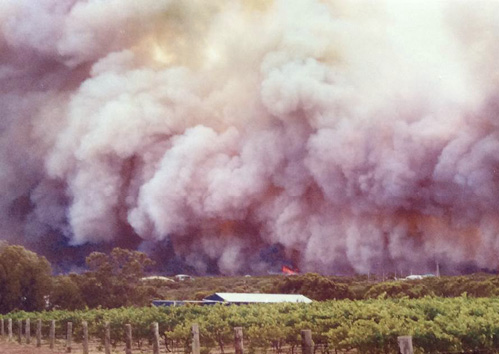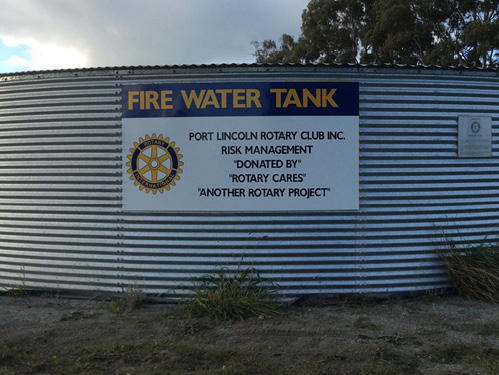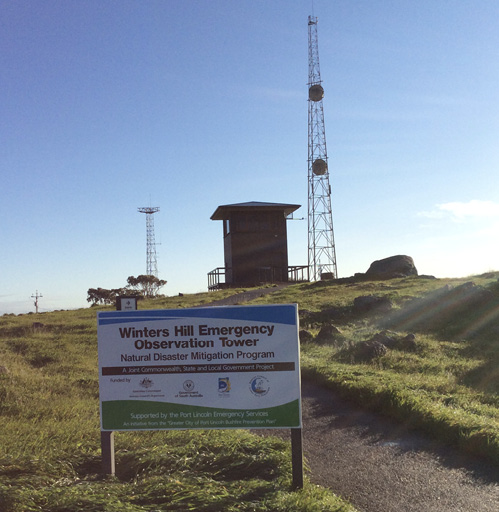
Submitted: 23 July 2017. Accepted: 12 September 2017.
A serious fire affecting people, their livelihoods and immediate social environments (the social ‘microclimate’) is a complex non-routine social problem (Drabek 2004). Discerning how people and emergency managers can better equip communities to protect themselves and the things they hold dear is an imperative given the evidence-based predicted changes to near-future global weather events. Recent severe natural hazards are acknowledged as an indicator of a ‘new normal’ of extreme weather (New Scientist 2013, Beynon 2016, Lewis 2016) that requires prioritisation of innovative preparedness initiatives.
Fire science explores an expanding spectrum of fire-related social, physical and agricultural science topics and has become a sophisticated research field in many wildfire-prone countries. This knowledge contributes to the successful and dynamic management of increasingly complex fire problems affecting many aspects of human populations. This study contributes to this knowledge base. It records, documents and analyses some of the experiences, expectations and needs of communities that have ‘lived through’ bushfire emergencies, and expect to face this hazard again. Th
Using a pragmatic qualitative approach, a case study of a bushfire at-risk regional area in South Australia—‘the driest state in the driest continent’ (Department of Environment Water and Natural Resources 2016)—was chosen as the research site because of its recent and severe fire history and diversity of animal ownership (South Australian Country Fire Service 2016). Fire can become an emergency when it impacts adversely on people, property, the environment and other assets - including commercial viability, business continuity and family legacy to future generations. Experience of such an event, and loss of any kind, can dramatically impact upon human physical and psychological health for variable timeframes, whether in an urban, semi-rural or pastoral environment (Gordon 2009, Chur-Hansen 2010, Gordon 2015).
To help people and their social and physical microclimates become ‘fire-fit’ requires preparedness behaviour to transition from being a desirable, although time-consuming, ‘optional extra’ to a regular activity which is as routine as buying the groceries or putting fuel in a motor vehicle. In Australia and elsewhere, household levels of fire-fitness are disproportional to the magnitude of public resources assigned to help people achieve bushfire readiness (Ronan & Johnston 2005, Paton 2013, Westcott et al. 2017a). Actively cultivating sustainable patterns of behaviour to establish and maintain a culture of preparedness can be achieved through innovative public policies that build capacity and enhance resilience in the medium and long-term. T

The need for new, practical strategies to evolve and problem-solve natural hazard public policy and practice (Gibbs et al. 2013, Gibbs et al. 2016) identified a pragmatic approach within a critical realist ontology and contextualist, experiential epistemology as the most appropriate framing for the study (Cornish & Gillespie 2009, Braun & Clarke 2013, Savin-Baden & Major 2013). For further information, this method is described in detail in Westcott et al (2017a). Participant groups were emergency responders (operational members of the South Australian Country Fire Service, State Emergency Service, Metropolitan Fire Service and South Australia Police) and the owners of any kind of animal. This included farmers, small business owners and owners of companion, recreational and assistance animals, or carers of wildlife. This demographic is important for two reasons:
Data were collected using semi-structured interviews and six focus group discussions with 69 participants. Thematic Analysis (TA) was used for data analysis because of its flexibility and independence from theory. This interpretative, inductive, data-driven approach enabled straightforward answers to practical questions. The recursive process of analysis was coded and managed with CAQDAS1 software, NVivo 11. A thematic map and table were generated to visualise actively identified thematic inter-relationships in the data (Westcott et al. 2017a). Pseudonyms are used to protect participant identity.
Data analysis of the preparedness theme, ‘Be fire-fit:
weekly is worth it!’ (so-called to connect routine behaviour (fire-fitness) with frequency (weekly) and net benefit (is worth it)) identified three areas of new policy. These areas have the potential to establish prerequisite conditions that favour routine fire-fitness and improve longer-term public health and safety outcomes.
In Australia, the public are notified of an approaching ‘catastrophic’ Fire Danger Rating (FDI) at 4.00 pm the previous day by the Bureau of Meteorology (BoM) (Bierman P. personal communication 2016). This information is available via the BoM website. However, people are faced with the dilemma of what to do on a catastrophic day even if they have a well-written and established bushfire survival plan. A myriad of commitments can present as obstacles, including the requirements of the workplace.
Residents need time to enact their plan. This dilemma, and workplace difficulties experienced by employees when requesting leave of absence during the 2013 ‘Red October’ bushfires in New South Wales, is reported by Wilkinson and colleagues (2015). A formal contractual arrangement with employers could overcome this difficulty.
Catastrophic Day Leave (CDL) is proposed as a new workplace agreement that allows employers and employees to negotiate substituting another type of leave or entitlement (e.g. recreation leave or overtime) with an agreed number of CDL days. Potentially, such a policy could encourage others to establish plans and arrangements within their networks, promoting a culture of shared responsibility with mutual workplace and community benefits, thus elevating a culture of bushfire preparedness to ‘business as usual’ status.
Senior firefighter, Shane, described the dilemma of time-poor families trying to juggle preparedness and their daily commitments:
CDL is not intended to replace leave already granted to employees who are emergency services volunteers for the purpose of participating in an emergency response. Nor would it be used for out-of-season preparedness work as this should be done in a property owner’s own time on non-catastrophic days. While CDL would not be particularly helpful to people who are self-employed, and catastrophic days could outnumber available days of leave, it recognises and proactively addresses the need to implement necessary societal-wide changes that are proportional to preparing for the ‘new normal’ of changing weather events (Council of Australian Governments 2011, Gibbs et al. 2013, Gibbs et al. 2016).

Prevention and preparedness initiatives are vastly less costly than response, relief and recovery operations (Attorney-General’s Department 2014, McClean 2017). In combination with CDL, carefully designed, locally targeted financial incentives could encourage the integration of widespread fire-fitness preparedness behaviours into daily routines. In the business focus group, Sandy said, ‘people respond very well to financial incentive’.
Currently, emergency services levies are applied in some form to land owners in all Australian states and in the Australian Capital Territory (State Custodians 2017). This is frequently resented in rural areas where land owners may have mainly non-cash assets, usually comprise a large proportion of the available firefighting personnel and resource a response themselves with their own on-farm firefighting vehicles (‘farm fire units’). Property owners therefore seem to pay the levy and also fight fires with their own equipment, often leaving their own farms and homes to contribute to community wellbeing. This mismatch could be overcome by separately rewarding best-practice fire preparedness.
Local councils have inspectors with the power to issue fines to land owners on residential or rural living blocks who fail to make their properties fire-ready. A relatively simple extension of this system could see preparedness rebates issued, as well as fines. Arguably, a rewards-based method of acknowledging best-practice preparedness could be more effective than the absence of a fine.
Volunteer rescue officer June spoke with respect to her role as a local government inspector:
An expansion of the inspectorate would be necessary to include farms. This could be facilitated by the use of ‘drone’ technology (Unmanned Aerial Vehicles (UAVs)) or by land owners up-loading their own photographic or video evidence for assessment to overcome issues of privacy. Additional costs could be offset by savings because response and recovery are more expensive than preparedness activities (Attorney-General’s Department 2014).
Participants in both groups were eager to find new ways to help urban migrants learn more about bushfire hazards for their own and the community’s safety. New people could readily receive current information and assistance by attending non-compulsory community fire safety information sessions. They could be encouraged to do so via an invitation accompanying their first Council (Shire) rates notice that offers attendees a meaningful discount on the second year’s rates. To qualify, participation in a given number of fire information seminars would be required, which could be spread over a 12-month period to give maximum opportunity for people to participate. This kind of education could overcome new residents’ misconceptions, as noted by Shane:
Extending existing community achievement and award programs could be another way to promote a culture of bushfire safety and help build strong relationships with emergency services organisations. Civic awards similar to the 1970s ‘Tidy Towns’2 program, such as ‘Bushfire Best-Prepared Towns’, could attract additional funding from government or corporate sources. Such initiatives can enhance community pride and collaboration and boost the local tourism economy.

Identifying ‘bushfire-safer properties’ that comply with current Australian Standards (Standards Australia 2009) could help build routine fire-fitness by attracting higher selling prices and encouraging other property owners to similarly value-add. This may be facilitated by linking to a rebate scheme as suggested above, and by applying appropriate annotation. Properties not intended for sale could be promoted as exemplars of fire-fitness by joining existing programs such as the Australia-wide ‘Sustainable House Day’3 or other ‘open house’ style programs similar to ‘open gardens’ to showcase and educate others to do likewise. As this concept is already established and understood within communities, extending it to fire-safe properties is an achievable extrapolation.
The influences of modern ‘conservation farming’ techniques on fire behaviour were independently discussed by farmer and emergency responder participant groups. No-till cropping, greater productivity, the popularity of oil-seed crops and reduced farm firebreaks all contribute and need further research.
Sheep and wheat farmer Paul noted:
Farmer Trevor added:
From a wheat and sheep property further north, Bob observed:
Paul added that a review of firebreaks is overdue in the context of modern farming practice:
Making fire-fitness a routine social norm requires all stakeholders to proactively reassess what precedes preparedness to implement changes with medium to long-term public benefit. Proactive campaigns can resonate with more people by adopting innovative social strategies such as CDL and targeted financial incentives. These methods need trialling and evaluation to determine how best to narrow the awareness-preparedness gap. Additionally, further research is required to accurately determine how modern farming practices and crop types influence fire behaviour to unequivocally manage and balance productivity versus safety. Given the predicted increase in extreme weather and fire severity, the challenge of transitioning fire-fitness to become a social norm—thus fortifying community wellbeing in a bushfire emergency—requires a dynamic, problem-solving paradigm melded from science, government and the at-risk communities themselves.
This research is supported by funding from the Bushfire and Natural Hazards CRC. Thanks are extended to Dr Mel Taylor, Professor Kevin Ronan, Professor Hilary Bambrick and Dr Susan Mowbray for their help and support during this project. Grateful thanks also to the communities and Emergency Services of Lower Eyre Peninsula.
Animal Medicines Australia 2016, Pet Ownership in Australia 2016, Animal Medicines Australia, Canberra.
Attorney-General’s Department 2014, Productivity Commission inquiry into natural disaster funding arrangements. Australian Government, Canberra.
Braun V & Clarke V 2013, Successful Qualitative Research, London, Sage.
Chur-Hansen A 2010, Grief and bereavement issues and the loss of a companion animal: People living with a companion animal, owners of livestock and animal support workers. Clinical Psychologist, vol. 14, pp. 14-21.
Cornish F & Gillespie A 2009, A Pragmatist Approach to the Problem of Knowledge in Health Psychology. Journal of Health Psychology, vol. 14, pp. 800-809.
Council of Australian Governments 2011, National Strategy for Disaster Resilience: Building Our Nation’s Resilience to Disasters. Department of the Prime Minister and Cabinet. Canberra:
Department of Environment Water and Natural Resources 2016, Managing natural resources. Government of South Australia, Adelaide. At: www.environment.sa.gov.au/managing-natural-resources/water-resources [12 September 2017].
Drabek TE 2004, Social Dimensions of Disaster, Emmitsburg, Emergency Management Institute, Federal Emergency Management Agency.
Gibbs L, Bryant R, Harms L, Forbes D, Block K, Gallagher HC, Ireton G, Richardson J, Pattison P, MacDougall C, Lusher D, Baker E, Kellett C, Pirrone A, Molyneaux R, Kosta L, Brady K, Lok M, van Kessell G & Waters E 2016, Beyond Bushfires: Community Resilience and Recovery Final Report. Melbourne: University of Melbourne.
Gibbs L, Waters E, Bryant RA, Pattison P, Lusher D, Harms L, Richardson J, MacDougall C, Block K, Snowdon E, Gallagher HC, Sinnott V, Ireton G & Forbes D 2013, Beyond Bushfires: Community, Resilience and Recovery - a longitudinal mixed method study of the medium to long term impacts of bushfires on mental health and social connectedness. BMC Public Health, vol. 13, p. 1036.
Gordon R 2009, Community impact of disaster and community recovery. InPsych - Australian Psychological Society.
Gordon R 2015, How do people and communities react and recover after the fires. Community information sessions, Melbourne.
Lewis S 2016, Time to adapt: 2015’s record-breaking temperatures will be normal by 2030. Sydney: Australian Broadcasting Corporation. At: www.abc.net.au/news/2016-11-07/record-breaking-temperatures-will-be-new-normal-by-2030/8001720 [12 September 2017].
McClean D 2017, Australia integrates climate and disaster risk. Geneva: United Nations Office for Disaster Risk Reduction. At: www.unisdr.org/archive/52874 [1 May 2017].
New Scientist 2013, Wild weather: extreme is the new normal. At: www.newscientist.com/article/mg21729003-200-wild-weather-extreme-is-the-new-normal/ [12 September 2017].
Paton D 2013, Disaster Resilient Communities: Developing and testing an all-hazards theory. Journal of Integrated Disaster Risk Management, vol. 3, pp. 1-17.
Ronan KR & Johnston DM 2005, Promoting Community Resilience in Disasters: The Role for Schools, Youth, and Families, Springer US.
Royal Society for the Prevention of Cruelty to Animals 2014, How many pets are there in Australia? At: http://kb.rspca.org.au/How-many-pets-are-there-in-Australia_58.html [12 September 2017].
Savin-Baden M & Major CH 2013, Qualitative Research, Abingdon, Routledge.
South Australian Country Fire Service 2016, Bushfire History. Adelaide: South Australian Country Fire Service. At: www.cfs.sa.gov.au/site/about_cfs/history_of_the_cfs/bushfire_history.jsp [12 September 2017].
Standards Australia 2009, Australian Standard® Construction of buildings in bushfire prone areas. Sydney: Council of Standards Australia.
State Custodians 2017, Changes to fire services levy to affect home owners. Charlestown: State Custodians. At: www.statecustodians.com.au/changes-to-fire-services-levy-to-affect-home-owners [8 May 2017].
Westcott R 2017, What comes first? Building DRR by cultivating a preceding culture of preparedness as a ‘social norm’. PreventionWeb DRR Voices. At: www.preventionweb.net/experts/oped/view/54363 [12 September 2017].
Westcott R, Ronan K, Bambrick H & Taylor M 2017a, Don’t Just Do Something…..Stand There! Emergency Responders’ Peri-Incident Perceptions of Animal Owners in Bushfire. Frontiers in Veterinary Science, vol. 4, p. 34.
Westcott R, Ronan K, Bambrick H & Taylor M 2017b, Expanding protection motivation theory: investigating an application to animal owners and emergency responders in bushfire emergencies. BMC Psychology, vol. 5, p. 13.
Dr Rachel Westcott is a First Class Honours veterinary graduate of Murdoch University in Perth, Western Australia, and is nearing completion of a PhD with the Bushfire & Natural Hazards CRC and Western Sydney University as part of the Managing Animals in Disasters project. She is a veterinarian in private practice and the coordinator of South Australian Veterinary Emergency Management Inc, an agency of the South Australian State Emergency Management Plan. Her PhD research focuses on public health, by making preparedness for natural hazards a social norm.
1 Computer Assisted Qualitative Data Analysis System
2 ‘Tidy Towns’ is an initiative of the Keep South Australia Beautiful (KESAB) campaign that began in 1978. It is now known as the Sustainable Communities program. See: www.kesab.asn.au/programs/sustainable-communities/program-information.
3 Sustainable House Day at: https://sustainablehouseday.com/about-shd/.